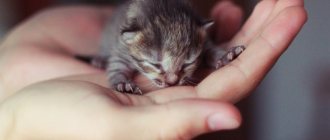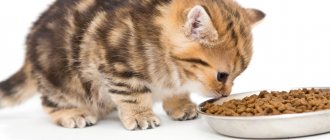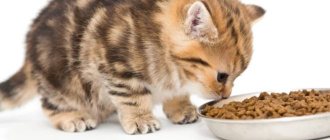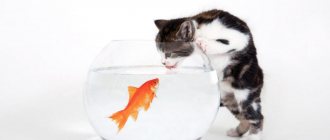What will you learn from the article?
- What to greet a kitten with Tray
- Toilet filler
- Dishes
- scratching post
- Combs
- Toys
- Sprays
- Carrying
- Toothbrush and toothpaste
- What should you not feed your kitten?
- Trimming a kitten's claws
- Playing with a kitten
- Deworming a kitten
If you think that you know everything about kittens, the basic recommendations on how to care for a kitten will be useful both for those who have already dealt with the cat breed and for those who have a kitten for the first time.
What to greet a kitten with
English folk wisdom says that, according to the cat, all things belong to cats. There is a grain of truth in this statement. But still, before you bring a kitten, you need to purchase several things that will belong exclusively to your future “relative”.
So - a small reminder “How to care for a cat and what should be purchased by the time a kitten appears in the house.”
Tray
No one has canceled natural needs and it is unlikely that anyone wants a kitten to relieve itself in an apartment, in a secret corner. Street cats, of course, do not know comfort, but indoor kittens (and especially their owners) need a proper cat litter box first and foremost.
In short, there are three types of trays:
- closed (so-called Eurotoilet);
- open with filler;
- open without filler with lattice;
The first (closed) are aesthetically pleasing, but expensive. This type of litter tray requires a gel or silica gel filler that blocks odor. The advantages of this type of tray are obvious - they are discreet, tidy and pleasant in appearance. One of the disadvantages is the large size of the toilet, for which there may simply not be room in the house!
The open type of tray with filler is the most common and, perhaps, convenient for apartments and for a four-legged baby. Recommendations from “experienced” people are unanimous that there is no need to buy a small tray for a kitten. Regardless of age, the baby will overcome the high sides and you will save on constantly changing toilets. So immediately buy a tray “for growth”, especially since any fillers are suitable for this type and they are very easy to disinfect.
Advice to purchase a tray without filler with a grid is addressed to those who are constantly at home and can often rinse the grid and the tray itself. From time to time, flush the toilet with special products containing chlorine, and may the absence of odor and a happy kitten be with you!
Read how to train a kitten to use the litter box.
There are also special trays for accustoming a kitten to a human toilet.
Read how to train a kitten to use the toilet.
In the video you can learn the general rules for those who don’t mind sharing a “white friend” with their animal:
Toilet filler
Keeping a kitten will be comfortable for both of you if the kitten likes the litter, in a figurative sense, of course. Although, if you observe a one-month-old kitten, you will find that he will probably try the filler on his tooth.
There are three types of fillers:
- locking;
- clumping;
- absorbent.
The burying instinct, inherent in the kitten by nature, should be realized at the moment when he “powdered his nose.” Therefore, do not skimp on the filler, let the baby dig up enough and, therefore, enjoy going to the toilet.
Locking fillers are considered the most economical This filler is poured in large quantities into a tray, moisture flows down the granules and is absorbed only in the lowest layer. The top layers remain clean and prevent odor from spreading. When most of the surface turns yellow, the filler is refreshed.
Clumping filler dissolves with moisture, forming round clumps. They are removed with a special sifting spatula, and filler is added as needed.
Absorbent fillers are the most inexpensive and environmentally friendly. They are made mainly from sawdust, paper, etc. You can also remove it in parts, as it gets dirty.
Dishes
Let the Saxon porcelain set continue to stand in the sideboard, as a memory of your great-grandmother - for the kitten you need to purchase only three bowls in advance (by the way, porcelain ones are also possible). One bowl is needed for water. It should be as stable as possible. The other two are for dry food and for liquid food. Bowls should be easy to clean and comfortable for the kitten.
If you are often away from home for long periods of time, we advise you to buy an automatic feeder and a drinking fountain.
scratching post
If you don’t buy a scratching post or put off this purchase until “later,” then you will have to buy a new sofa or leather corner for the kitchen. And it’s not about the cat’s harmfulness at all! Kitten cats don't just sharpen their claws. This ritual is an exercise for them, without which the animal feels uncomfortable. There will be no scratching post - the baby will replace it with furniture or wallpaper. From the first day, take the baby to a special post or even a complex wrapped in sisal thread, and show the kitten what to do with this happiness.
To consolidate the effect, spray the scratching post with liquid catnip, which is so attractive to cats.
A little patience will ultimately save your furniture and nerves! Try making a cat scratching post with your own hands according to the video instructions.
Combs
Yes, on the dressing table of a decent kitten there should be a comb, or better yet several at once - the rule of caring for kittens. Of course, if your pet is not a sphinx or a charming greyhound. Human hair care products are absolutely not suitable for babies! Plastic combs are also not suitable for them, since they strongly electrify the fur.
Metal scratchers with wide teeth are optimal. Brushes that fit on your hand are very convenient.
IMPORTANT! Try not to use slickers, better known as slickers! They are needed in preparation for exhibitions, and in normal, non-show mode, the kitten’s fur can be greatly damaged by the slicker.
Toys
The baby needs toys. Like any baby, a cat child will look for a toy. It could be a gold ring left out of habit under the mirror or a torn button. Therefore, buy a couple of toys in advance. Balls, fur mice, rattles or feathers on a stick will help the kitten brighten up the first days of separation from its mother cat. Or make your own cat toys.
Sprays
Caring for a kitten for 1 month will be quite difficult. Until your patience and love develop acquired instincts in your baby. Special sprays can help with this! They can be repellent or habituating.
You will need the first ones to protect those places that the cat can damage or to wean her from going to the toilet in the wrong place.
Attraction sprays are good for crate training or house training.
These sprays are completely safe for the animal and very effective!
Carrying
Newborn kittens were initially handled by the breeder. From the moment he has handed over the banner of responsibility to you, you will have to visit the veterinarian regularly. Therefore, carrying is simply necessary. It can be fabric or plastic (depending on the size, temperament of the cat and the geography of transportation). For those who are going on a trip by train or plane, a hard plastic carrier is needed; traveling in a car is convenient with a soft carrier.
By the way, while the first trip is still looming in the future, it is convenient to use the carrier as a house for the baby. Place a diaper in it that smells like its first home and the kitten will feel safe in the carrier.
Toothbrush and toothpaste
Problems with teeth and gums in cats often lead to serious illnesses. You need to start caring for your baby’s oral cavity from a young age. Otherwise, later this procedure will be painful for everyone.
Beef or salmon flavored toothpastes and comfortable toothbrushes should relieve possible dental problems. It is very easy to care for a cat that has been accustomed to procedures since infancy.
The video below shows a short dental course:
Scratching post for a kitten
The first thing you need to care for a Scottish kitten is to purchase a scratching post, preferably a more stable one. It is better if it is combined with different fur houses. It's actually very inconvenient in the sense that it's very difficult to clean.
- Many people use a very ordinary scratching post, which is very high. Some cats prefer to sharpen their claws at the top of the scratching post, while others, on the contrary, prefer to sharpen their claws at the bottom.
- It’s worth saying right away that the process of accustoming a kitten to a scratching post will require the owner to purchase more than one scratching post.
- In fact, animals have completely different needs for how exactly they will sharpen.
Some cats like to scratch off the floor, so they get a flat scratching post that just sits on the floor. Some cats, on the contrary, like to fully extend their body, so a tall one is suitable for them.
Kitten nutrition
Everything that is not prohibited is permitted. In fact, this is the basic rule for creating a cat menu. But centuries of coexistence between people and cats have given rise to a lot of gastronomic myths. Care and feeding (and especially feeding) is an area of special responsibility. The approach to nutrition must be scientific - this is the basic rule of caring for kittens. The right menu is equally important for purebred kittens or their not so aristocratic brothers!
What should you not feed your kitten?
We warn you right away - there are many prohibitions and some of them will really surprise you. For example, we recommend forgetting about such “popular” milk. The cat’s body simply does not digest it and you will have to frequently remove undigested products from the tray.
In addition to milk, kittens should not:
- bones (chicken, fish);
- pork, goose, duck;
- sausages, smoked meats, saltiness;
- sweets in any form;
- potato;
- legumes;
- fish;
- egg white;
- salt, spices.
Read more about the bans here.
What should you feed your kitten? Natural nutrition
And again, we warn you right away - the food from your table is not suitable for a kitten. Be prepared to let your baby cook separately. So, what can and should be included in a kitten’s diet:
- raw frozen beef;
- boiled chicken meat;
- beef or chicken by-products;
- egg yolk;
- milk porridge (only for babies under 3 months);
- dairy products;
- cereals;
- vegetables raw or boiled.
And all this is not salty, warm and, of course, fresh!
Ready-made feed
Experts believe that ready-made industrial food significantly saves time on preparing breakfast, lunch, afternoon snack and dinner for a kitten. In addition, they are well balanced and with this diet there is no need to give the kitten additional vitamins.
Small animals are fed only with dry ready-made food (canned food is exclusively for adults!)
What feed should I buy? Those marked: “Premium” or “Superpremium”. Cheap ready-made food, alas, too often causes diseases, sometimes incurable.
For kittens you need to buy specialized baby food.
You should not mix food from different companies; such nutrition is no longer considered balanced.
Kitten diet
At home, it is better to feed a kitten on a schedule. If the baby is 2 months old, then he is fed 5 times a day.
A six-month-old kitten is fed less often, up to 3 times a day.
An 8-month-old kitten is equivalent to an adult cat and receives food 2 times a day.
Some breeds are prone to obesity, so regularly measure 90-60-90 and do not overfeed the animal.
Water
In addition to food, the kitten must have access to clean water and doubly so for those who feed the kitten with dry food. Cats are big enthusiasts when it comes to drinking water, they all have completely different quirks and British kittens are no exception. British cats prefer to drink from a container that they don't have to bend over to.
Kitten care
How to care for a kitten that is no longer under the care of the cat and the breeder? You took your baby to you at the age of three months (the most optimal age for separation) and now you are his mother, father and immediate family. And you need:
Trimming a kitten's claws
This procedure is easiest to do using special scissors. How to trim your baby's claws without causing pain?
If the kitten has white claws, then if you look closely, you will notice a pinkish tint. This pink area should be avoided when trimming nails.
If the claws are black, there is a high risk of injuring a sensitive area. Remove approximately 1 mm of the claw. This will be enough to prevent scratches on leather or furniture.
Read more in the article on how to trim claws.
Cleaning a kitten's ears
For some kittens, this procedure becomes their favorite. The question is - why do this? Firstly, to remove dirt. Secondly, to prevent ear mites. These tiny parasitic insects can live in the ear canals, causing infections and other problems. We remove them mercilessly!
Brushing our teeth
We wrote about this procedure above. Let us only add that the baby does not need to brush his teeth too often. Once a month is enough.
Combing out the wool
The coat (if any) should be brushed regularly, once or twice a week.
Bathing is completely contraindicated for some breeds, and for others due to severe contamination.
Maintaining thermal conditions
You need to equip a cozy house for kittens immediately, because it is important to warm the babies up as quickly as possible. When a mother cat is nearby, the kittens warm up by clinging to her warm side, but if the cat is not nearby, it is important to provide the babies with a temperature of around 20-22°C.
Therefore, as soon as you equip the house, place a warm (but not hot!) heating pad on the bottom. An alternative to a heating pad can be a plastic bottle filled with warm water. Such a bottle must be wrapped in cloth and placed with the kittens. This will prevent the kids from getting burned, and the water in the heating pad will cool down more slowly.
But watch the temperature. If the water in the heating pad begins to cool down, and the kittens begin to worry and shake, you need to change the water to hotter water. By the way, if there are a lot of kittens, it will be better if you put several bottles of water in the tray. This will prevent hypothermia for each baby. Alternatively, the kitten bed can be placed next to a warm radiator, stove, or other heating devices.
Important! It is necessary to warm kittens with a heating pad for at least the first two weeks of life, around the clock (including at night). If necessary, this heating can be maintained for up to a month of the baby’s life.
Features of caring for some breeds of kittens
British, Scottish kittens
Caring for these cats differs from usual in several nuances. The ears require special attention, which should be clean and smelling good. Ear care involves removing tassels if any appear on the ears. And, of course, grooming. British and Scottish cats are the only short-haired kittens that enjoy being brushed against the grain. Caring for cats of these breeds includes two brushings per week, long and massaging.
Sphinxes
The skin, eyes and ears of sphinxes need your regular help - the basic rules for caring for kittens of these breeds. Sphynx cats sweat, so their skin needs to be wiped with a damp sponge regularly. Random hairs that appear on the skin must be mercilessly removed. In addition, it is important to provide Sphynx cats with the opportunity to sunbathe a little (we emphasize, a little).
Since kittens of this breed do not have eyelashes, their eyes are more likely to become dirty. Rubbing with tea leaves or special drops solves this problem.
And the large (let us add, also very hot) ears of sphinxes are just a box for the accumulation of brown discharge. We clean the Sphynx's ear when there is a hint of contamination!
Shorthair cats (Abyssinian, Thai, exotic, Siamese)
These breeds do not require complex care. Regular cleaning of ears, teeth and eyes, gentle combing and cleaning of the mouth - and the kitten is fine!
Long-haired cats (Persians, Maine Coon, Siberian cat)
How to care for a cat so that its fur is of high quality? You will have to run with a tambourine, that is, observe a certain complex ritual. Firstly, arm yourself with an arsenal of combs, and secondly, remember the instructions for caring for a long-haired pet:
- collect fallen hairs with a mitten brush;
- Use a sparse comb to comb the fur in the direction of growth;
- Use a frequent brush to go over problem areas (stomach, panties);
- powder the wool. Voila - the kitten can be sent to a beauty contest!
Meowing, breathing and heartbeat
In the first days of a kitten's life, it is especially important to listen to the sounds that the babies make. Healthy and well-fed babies squeak extremely rarely. If they have enough, they sleep a lot and only express anxiety when they are hungry.
Exhausted kids attract attention. They scream heart-rendingly, can rush around the tray and sleep away from their brothers and sisters. Most often, this condition indicates weakness and dehydration of the body. If the kitten is also trembling all over, it is probably very cold.
To assess the condition of a mole rat, you can pick it up and check its heartbeat. Normally, in newborn kittens, the heart beats at a speed of 120-140 beats/min. As for breathing, the kitten should make 20-35 breathing movements per minute.
Important! If you observe serious abnormalities in your kitten's heartbeat or breathing, or if you see that the kitten is unwell, take it to your veterinarian immediately to determine the cause of the illness and take the necessary measures.
Kitten adaptation
The optimal age to adopt a kitten is 3 months. His immune system has already strengthened, his intelligence is developing, and his appearance is also visible.
How to make your baby accept your home as his own? Be prepared to help him with this for the first 3-4 weeks.
On the first day the kitten is in the house, limit its space to one room. Let him look around, sniff, and only then introduce him to the rest of the territory.
Playing with a kitten
Kittens develop better in games; they perceive their playmate as their friend, so don’t be lazy to spend 15-30 minutes every day playing with your baby. Some kittens are even better trained after this. Kids who were played with as children are more cheerful than kids who were not paid attention to.
Friendship with a dog or another adult cat
First, the animals need to be introduced. The advantage of a kitten is that it smells like childhood and an adult animal will sooner or later accept it anyway. During the first meeting, avoid direct contact. Lock the animals in different rooms, and then switch places. This way they will get used to each other's smells.
Afterwards, arrange a “confrontation” again. If there is no conflict, then consider that friendship will definitely happen.
Kitten and child
A child who is too young may inadvertently hurt the kitten. Therefore, contact should take place under the supervision of an adult. Older children need to be explained the rules of playing with a kitten. By the way, the latter must also feel the limits of what is permissible.
Read: The best cat breeds for a family with a child.
Conan the Barbarian or Destroyer Kitten
“A cat knows how to purr himself and forgive himself for anything.” However, the destruction that the baby causes is not small at all. To prevent damage, you can cover the furniture with double-sided adhesive tape, place valuable items at a height inaccessible to the baby, and remove flowers and photo frames higher up.
Limit the kitten's passage to hard-to-reach places and, as an alternative to trimming the claws, put special tips on the claws.
What to do before purchasing
It would not be superfluous to remind you that before getting a kitten, you need to check all family members for allergies.
- And you need to understand that this is not a temporary toy; the cat will be a kitten for a completely minuscule period of time.
- You should be determined to purchase a cat or cat.
Kitten health
Once you get a kitten, start listening to word of mouth. After all, it is very important to find YOUR veterinarian! Based on the advice of friends or reviews on the Internet, it will not be difficult for you to do this. At the first meeting, ask your future family doctor about nutritional recommendations, options for fighting parasites, the first signs of disease, and get a schedule of vaccinations and visits to the veterinarian.
Deworming a kitten
About 7 days before the first vaccination you need to do deworming. Subsequently, kittens undergo this procedure every three months until one year. It is optimal to use broad-spectrum drugs for the prevention of parasites.
Flea control
Fleas are no joke. It’s especially not funny for the little ones who have these parasites. They cause itching, allergies, dermatitis, lead to exhaustion and the development of blood diseases! Have we scared you? Anti-flea products come in five types: drops, sprays, shampoos, collars, tablets. Do not rely on your choice if your pet is still very young, but consult your veterinarian.
Vaccination
IMPORTANT! It is necessary to vaccinate both animals that live in the yard and those that do not leave the apartment. Both the first and second can get sick equally, so it’s better to be safe.
Kittens are vaccinated for the first time at the age of 8-9 weeks. In this case, vaccinations that do not contain the rabies virus are used.
Revaccination is carried out when the kitten is 12 weeks old. This complex vaccine already contains the rabies virus.
The next revaccination takes place once a year and then once every year.
The scheme may change slightly. Your veterinarian will suggest the best one.
How to help a kitten adapt to a new home
Elena, felinologist: “It’s best to adopt a kitten at three months. Cats adapt well to new conditions, especially at a young age. So you don’t need to make any special efforts for this. Unless it is initially advised to leave the kitten in one room where its feeder, drinking bowl, tray, toys and house are located. Within a couple of days, he will completely acclimatize there and you can release him to explore the rest of the apartment. If you have other pets, you need to make sure that they get to know the new tenant. For mischievous and overly active kittens, you can use special attracting or repulsive sprays to mark those places where you should not go, or vice versa, you should. Well, don’t let children, if you have any, squeeze the animal too much, at least until the kitten grows up. Although even then, for an animal, meeting children is, as a rule, very stressful.”
Kitten plays with a special toy











